-
Car Reviews
- All reviews
- Midsize SUVs
- Small cars
- Utes
- Small SUVs
- Large SUVs
- Large cars
- Sports SUVs
- Sports cars
- Vans
Latest reviews
- Car News
-
Car Comparisons
Latest comparisons
- Chasing Deals
The well-appointed mid-ranger of the highly regarded XC60 lineup ought to be a real goldilox proposition. But does the B5 Bright fall too short where it counts?
Disclosure time: I’d long recommended not to part with good money on a premium midsize SUV without sampling a Volvo XC60. And for many of the reasons in the blurb about the Swedish wagon outlined on that models’ Chasing Cars landing page:
It’s an “outstanding performer” with a “laidback image” and “genuinely premium experience” with “torquey and economical powertrains paired with a comfortable ride and well-built cabin”. And that’s indeed a sentiment I’ve believed for much of this generation’s six-year existence.
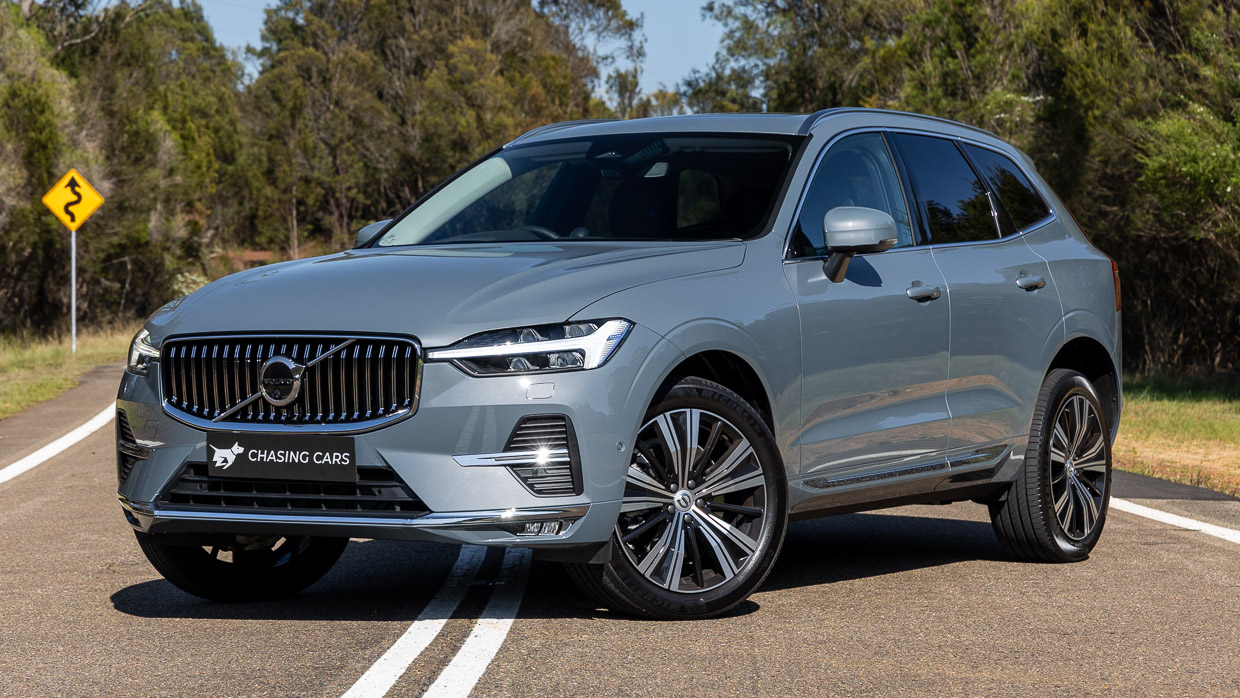
But six years is a long innings, particularly in what’s proven a fast-moving Volvo universe.
Since I’d first become an XC60 supporter, the diesels were dropped, the variant names had changed, Volvo’s entire lineup became electrified and there’s a promise that by 2026, the Swedish marque will be all-electric in Oz.
In the gen-two XC60’s lifetime, pure electric compact (EX30), small (XC40 and C40) and large (EX90) SUV models have arrived or are incoming and you can damn sure an electric replacement for the staple midsizer – dubbed EX60 of course – will surface globally sooner rather than later given Volvo Australia’s electric pipedream is just two years away.
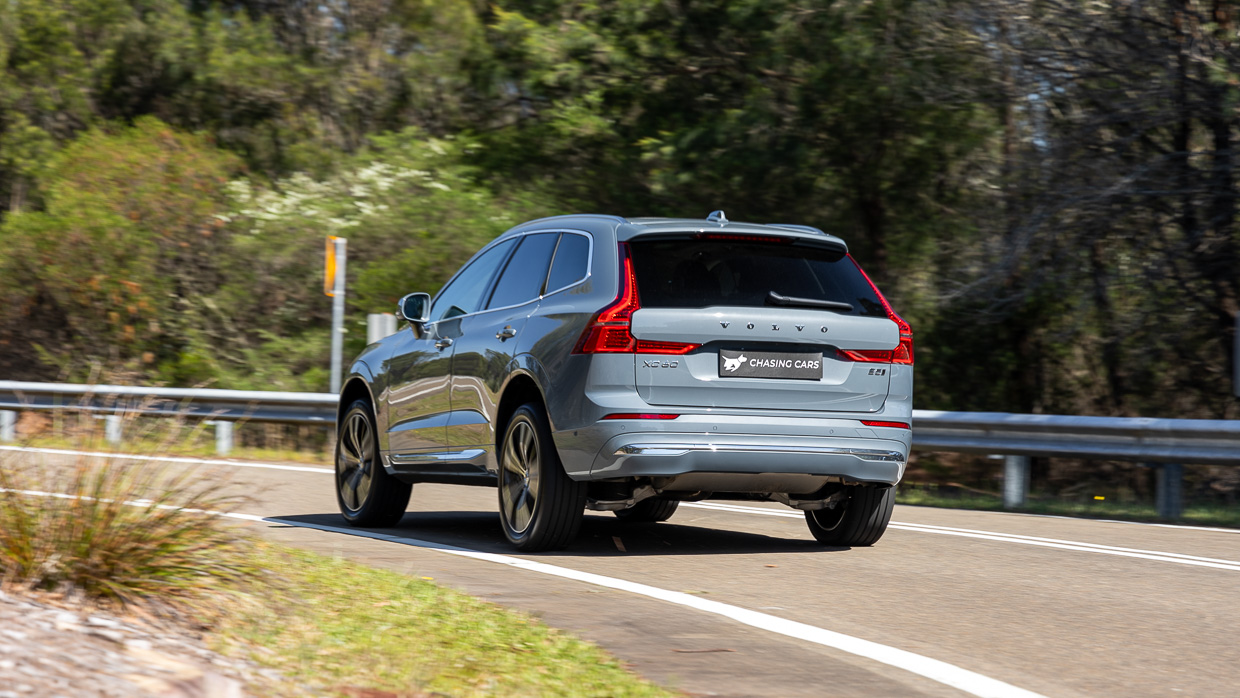
All of which poses an obvious question: is the XC60 the many have considered a premium medium-sized SUV benchmark still much chop today, six years in and headed for inevitable retirement on the mid-term horizon?
And is it much good with mild-hybrid low-output petrol B5 guise now that the diesels are gone and there’s a powerful and frugal T8 plug-in as the range figurehead?
That’s what we’re keen to find out with the XC60 Ultimate B5 Bright here before you.
In terms of direct rivals, the XC60 completes with stables of this segment including the BMW X3, the new-generation Mercedes-Benz GLC, the soon-to-be-replaced Audi Q5 and newer entrants to the space such as the Genesis GV70.
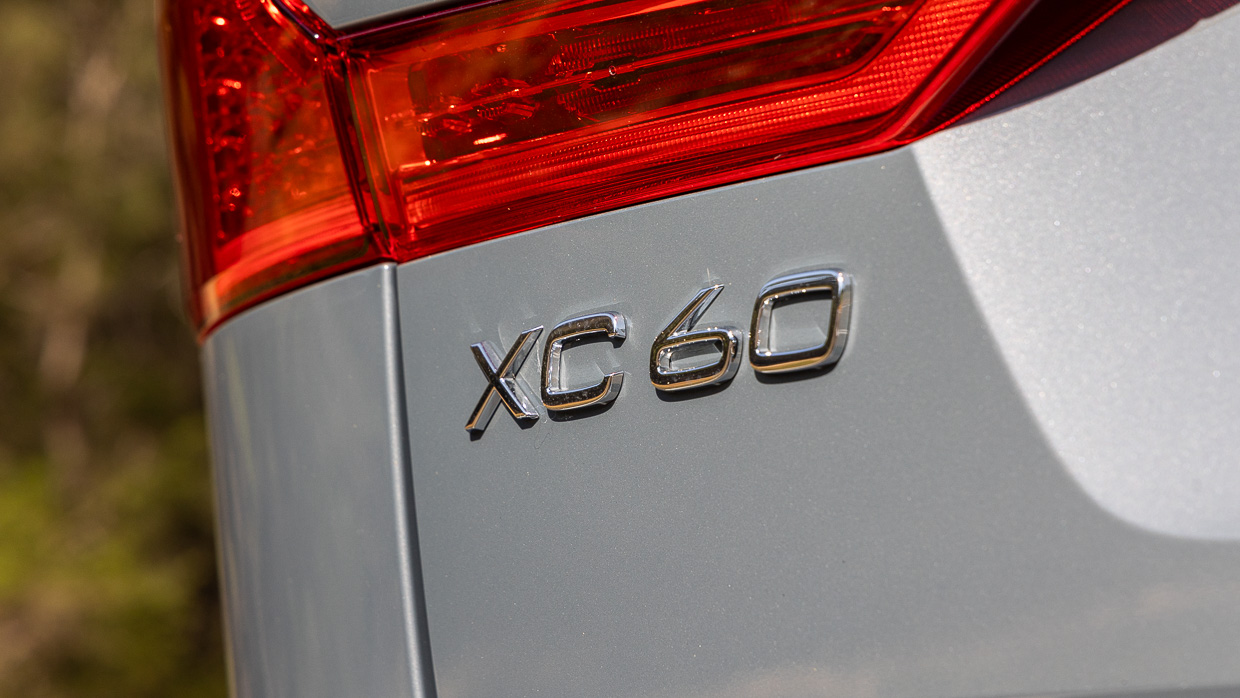
At $80,990 before on-roads, the Ultimate B5 Bright sits one rung above the entry Plus ($73,990), retaining the base ‘B5’ 183kW and 350Nm 2.0-litre turbocharged mild-hybrid petrol four if with the higher (Bright) level of standard equipment.
On paper, it could be viewed as something of a goldilox variant with the keenest value quotient of the four-strong variant lineup.
The next-rung-up Ultimate B6 Dark ($86,990) introduces a novel e-charger enhanced mild-hybrid 2.0-litre turbo powertrain, bringing an electric-powered compressor while yielding 220kW and 420Nm output peaks.
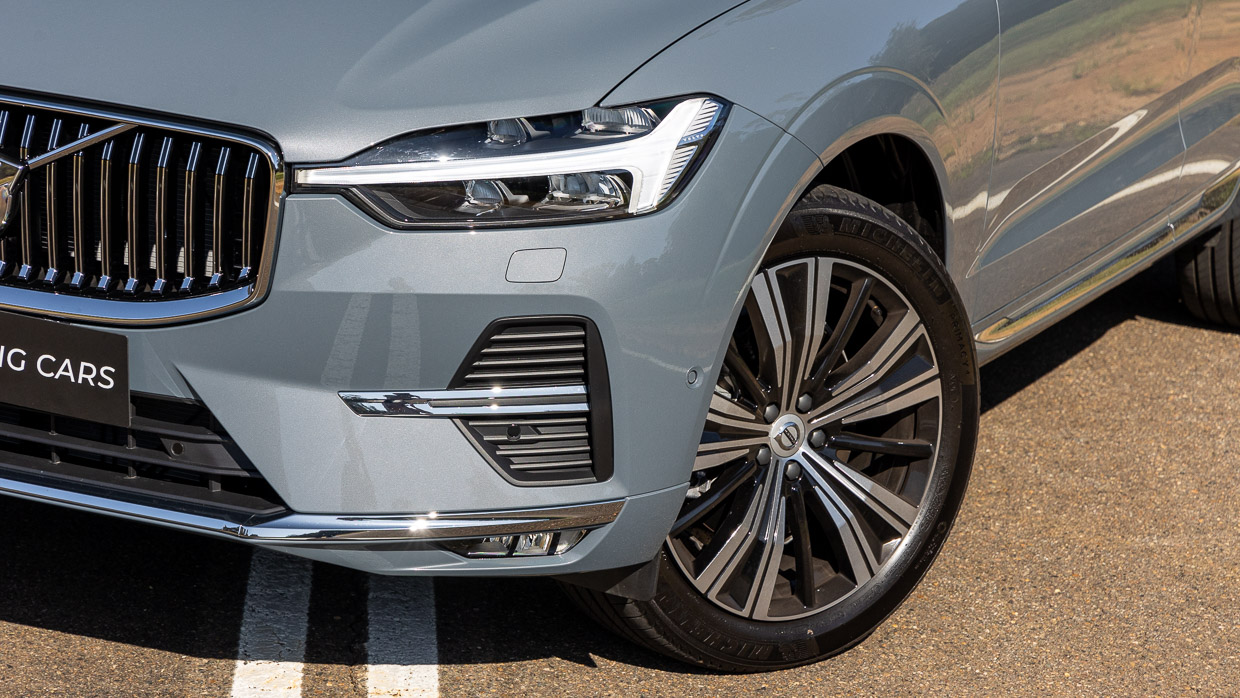
The range tops out with the Ultimate T8 ReCharge PHEV at $101,990, offering 340kW, a claimed 77 kilometres of pure EV driving per charge and heady 4.8sec 0-100km/h performance. A more affordable Plus version is also available from $92,990.
For this review, though, we’re focussing on the Ultimate B5 Bright, that brings a 6.9sec 0-100km/h promise and claimed 7.6L/100km combined frugality as cleanskin sans options.
But as we’ll soon discover, our test example does lay on a good number of optional extras that, for their part, start to add significantly to the Bright version’s bottom line.
As standard, the Ultimate B5 Bright includes the following features:
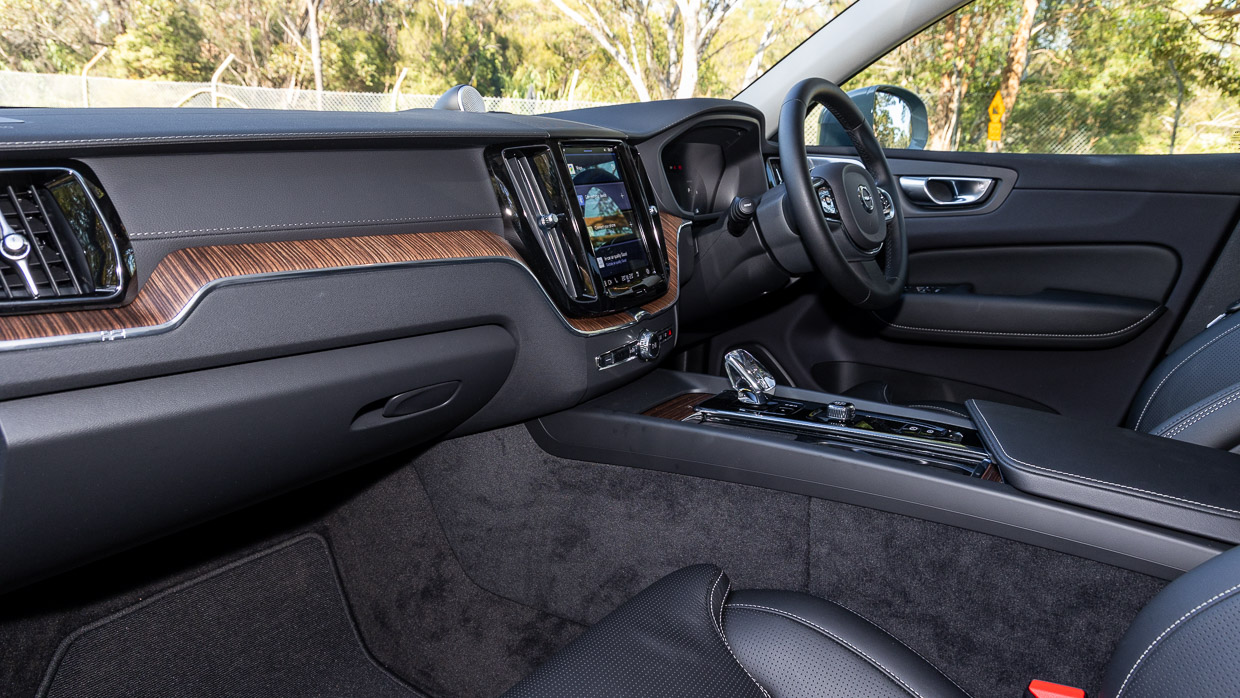
Our particular test vehicle adds $16,000 worth of cost optional extras that includes a Lifestyle Pack comprised of panoramic glass roof and Bowers & Wilkins sound ($6100), perforated/ventilated nappa leather accented trim ($3150), front seat massage functionality ($1100), air suspension with Four-C Active Chassis and Off-Road mode ($2700), rear tinted windows ($750), metallic paint ($2050) and headlamp cleaners ($150).
As optioned, our test vehicle, finished in Thunder Grey, clocks in at around $105,500 on road.
What does ‘mild hybrid’ mean in Volvo-speak? Well, it means internal combustion drive 100 percent of the time with some drivability augmentation via a self-charging 48-volt-powered starter generator (aka motor) housed in the transmission assembly.
Functionally, it adds torque off the mark during urban driving to reduce engine load to help reduce consumption and it also allows for a smoother operation of the stop-start system. What it doesn’t do is drive the vehicle on electric power alone, at all, ever.
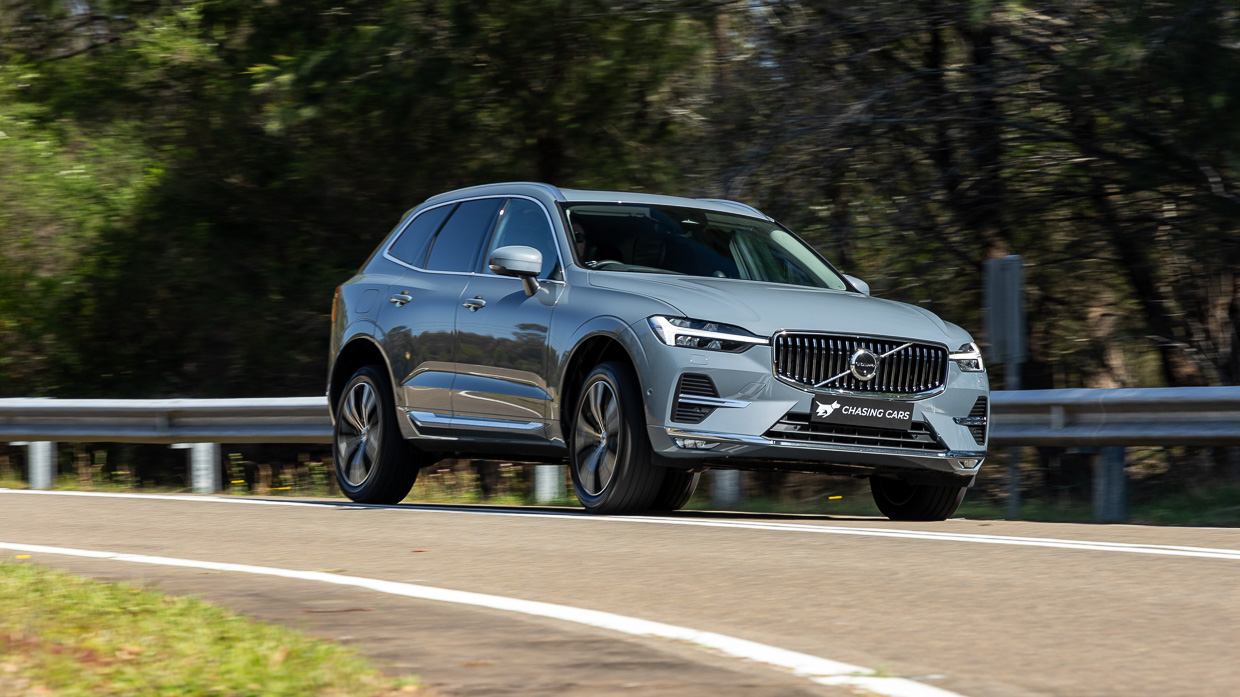
Does it work in theory? Well, its effect is frankly subtle enough that if it does add some refinement and pulling power (or torque, to be exact), it’s subtle enough to prompt the question whether the 48-volt engineering complexity at play is worth the modest dividends.
In short, the XC60 gets off the mark with reasonable enthusiasm and vigour. Those 183kW and 350Nm figures aren’t exactly anemic.
It’s just that the B5 powertrain lacks a decent low-to-mid-range shove, which leaves the engine feeling and sounding strained when called into much action whatsoever.
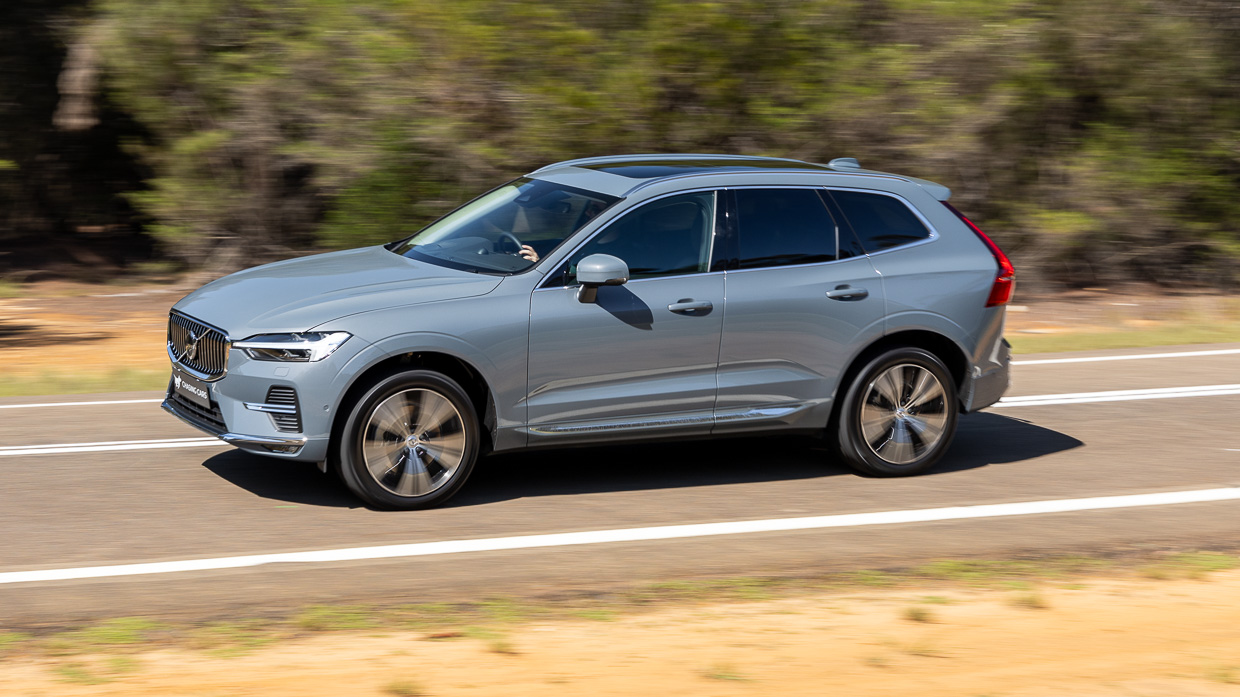
It’s a characterless turbo petrol four by default and one seemingly stressed enough that the driver isn’t really encouraged to raise the rpm much beyond 3000rpm.
None of this was present in the old and now defunct diesels.
And while it’s been a good while since I’d driven the electric compressor-equipped B6, memory suggests its lustier 220kW and 420Nm prowess also felt more robust and less strained during balanced stop-start driving where such character lends itself to improve refinement.
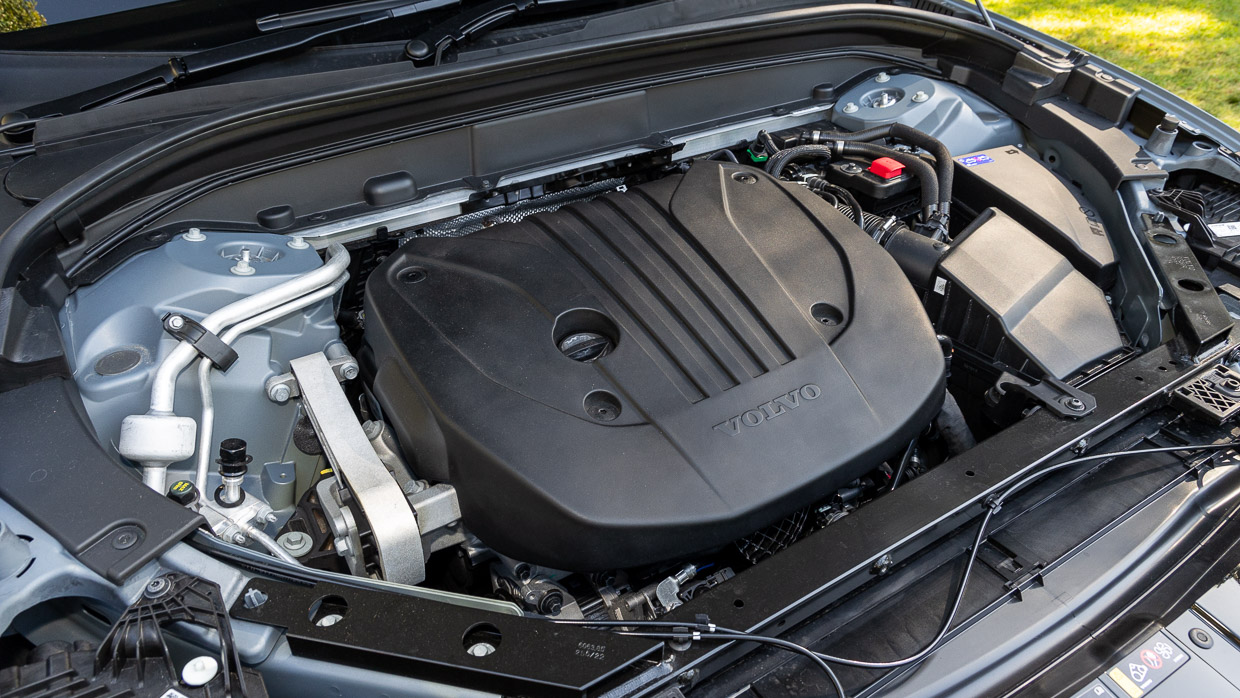
On our test track, the XC60 B5 was, at 7.44 seconds, quite a bit off its 0-100km/h performance claim of 6.9sec. And the more powerful B6 package is, by official claim, another seven-tenths quicker still (6.2sec).
All current XC60s fit a 2.0-litre engine, a torque converter eight-speed automatic and all-wheel drive, it’s just the peaky nature of the B5 unit elicits some stutters and palpitations through the driveline that see it struggle off the mark launched hard and noticeably unruly when negotiating slow moving traffic around town.
It’s the sort of stuff one hopes 48-volt electric enhancement might otherwise massage from the broader drivability experience.
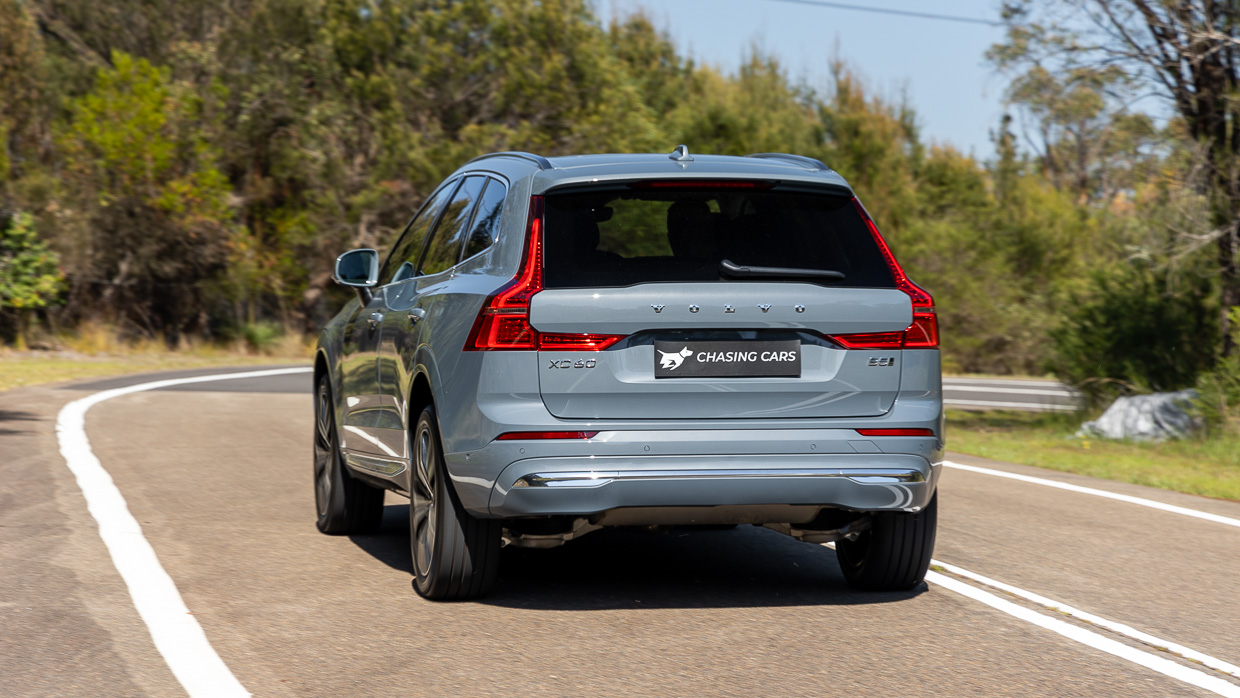
Another really strange quirk not limited to our B5 test example is the strange, occasional pause – a hiccup – in torque when negotiating 90-degree bends. It transpires that this is something of a running trait for this generation of this particular powertrain.
Nor is the B5 nearly as frugal as its 7.6L/100km advertised claim. Even driven gently, the 1830kg midsize SUV climbs to double figures where it likes to settle in for the long haul, unless you treat it to long light-throttle motorway stints.
Again, the ‘mild hybrid’ isn’t delivering what’s promised on the box, at least by any meaningful measure.
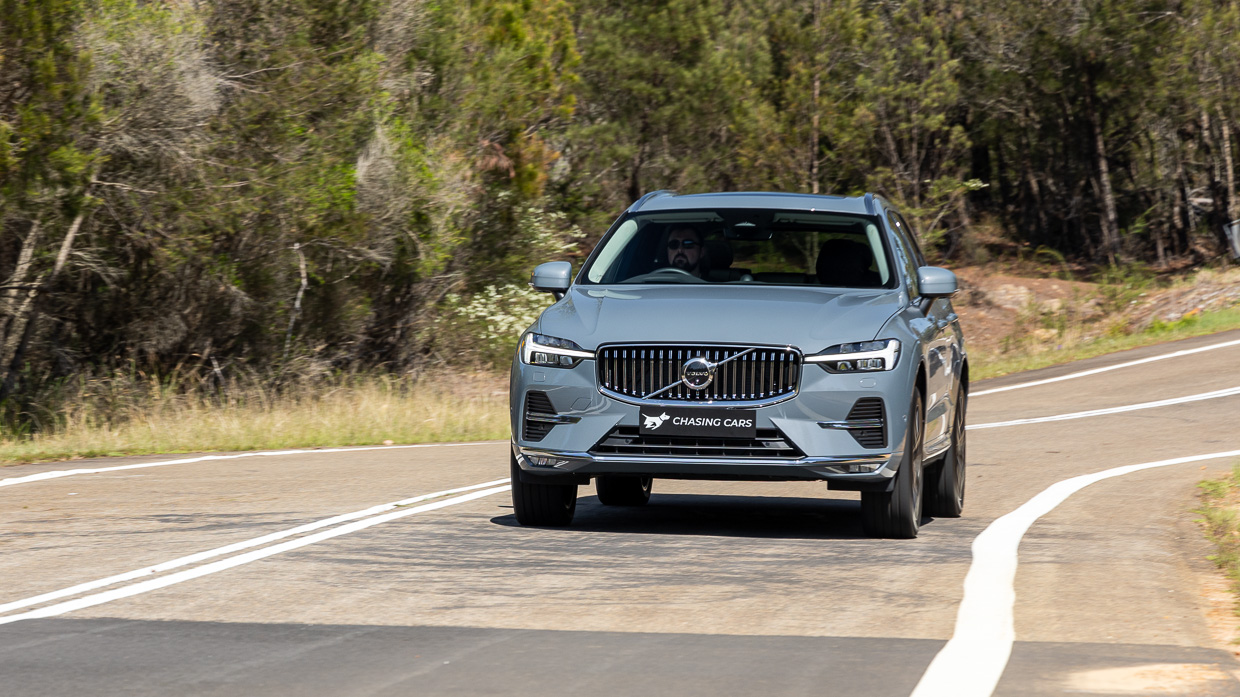
The rest of the on-road experience doesn’t feel nearly as compromised. In Chasing Cars’ experience, the ride on the standard-fit steel sprung passively damped suspension is fairly sharp and ordinary, but our rig sits on the optional air suspension and evidence suggests that its $2700 upcharge ought to be considered a mandatory addition.
On standard issue 20-inch wheels – 21s and 22s are optional – the bump control and compliance on the move is well controlled. And there’s enough body control blended into the tuning that there’s none of that floatiness or wobble that does afflict some premium German rivals.
The steering, too, is clear and direct, and the air-sprung XC60 does feel quite connected to the driver.
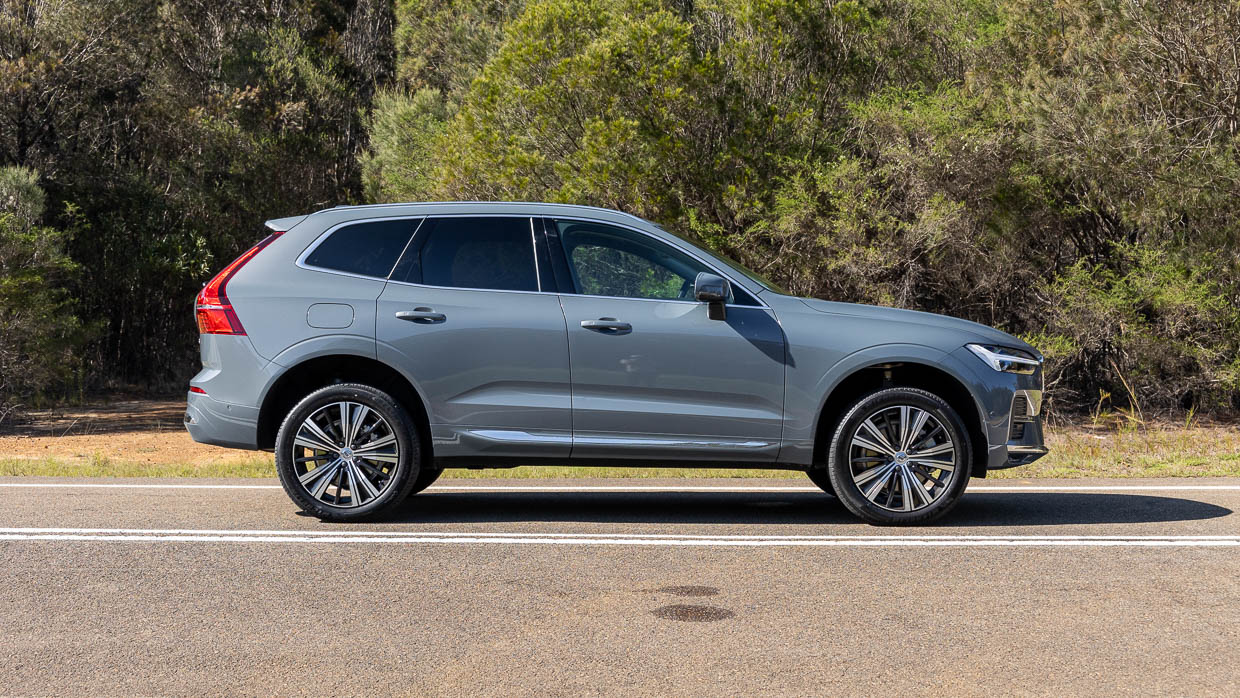
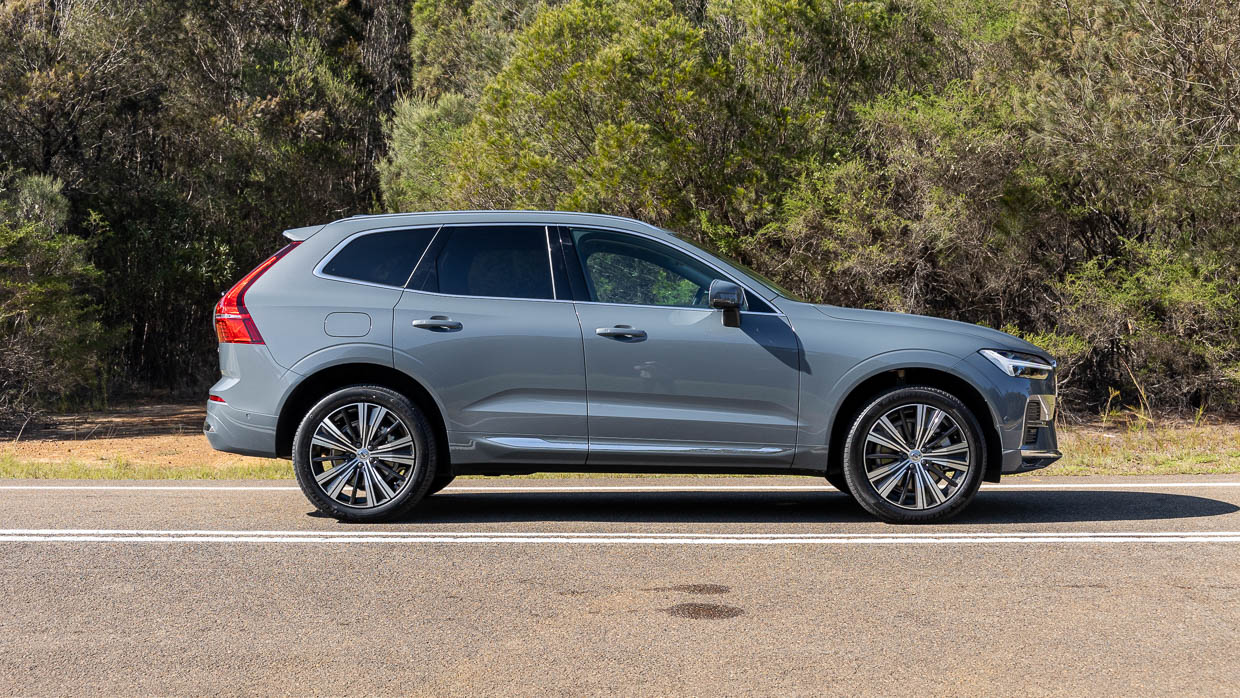
Pictured: the XC60 (above) raised in off-road model, normal ride height seen below.
But the suspension finds limitations at low speed and across sharp road imprections, particularly square-edge speed bumps.
Here, the suspension is prone to jolting that fires through the cabin, complete with more knocks and noise from the suspension than is perhaps less than ideal from such a premium-positioned offering.
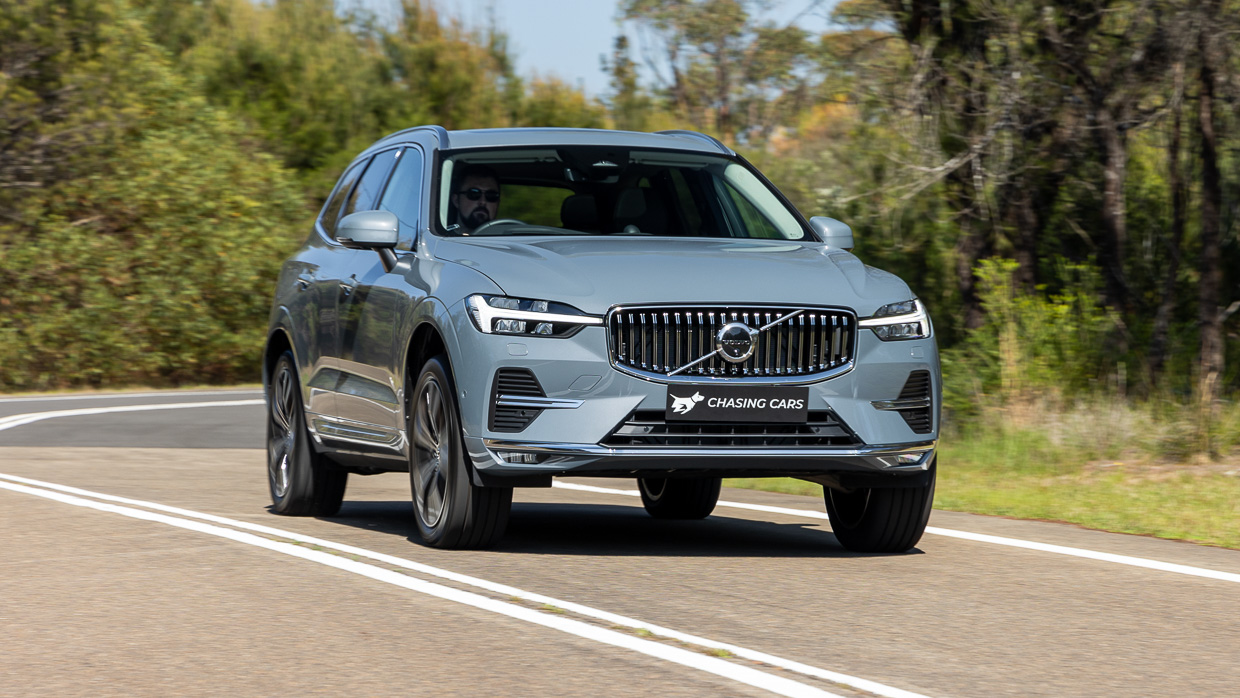
At its core, though, the XC60 B5 is a fine vehicle that’s generally serene in nature, that provides exceptional NVH isolation and genuinely feels comfortable. Outward visibility is excellent and it’s an easy car to place on the road and to park in tight situations.
But it is a little shabby in the last ten percent of the experience that does rob it of some on road dignity. And the biggest culprit for much of that is a powertrain simply more unruly than it ought to be.
There’s an effortless classiness to the XC60’s exterior design that continues through the interior that struck as simple and elegant when it first arrived six years ago and has aged wonderfully in times since.
It’s a charming and fetching antidote to the overwrought and sensory overloaded treatments celebrated by German rivals and remains a Volvo strong suit.
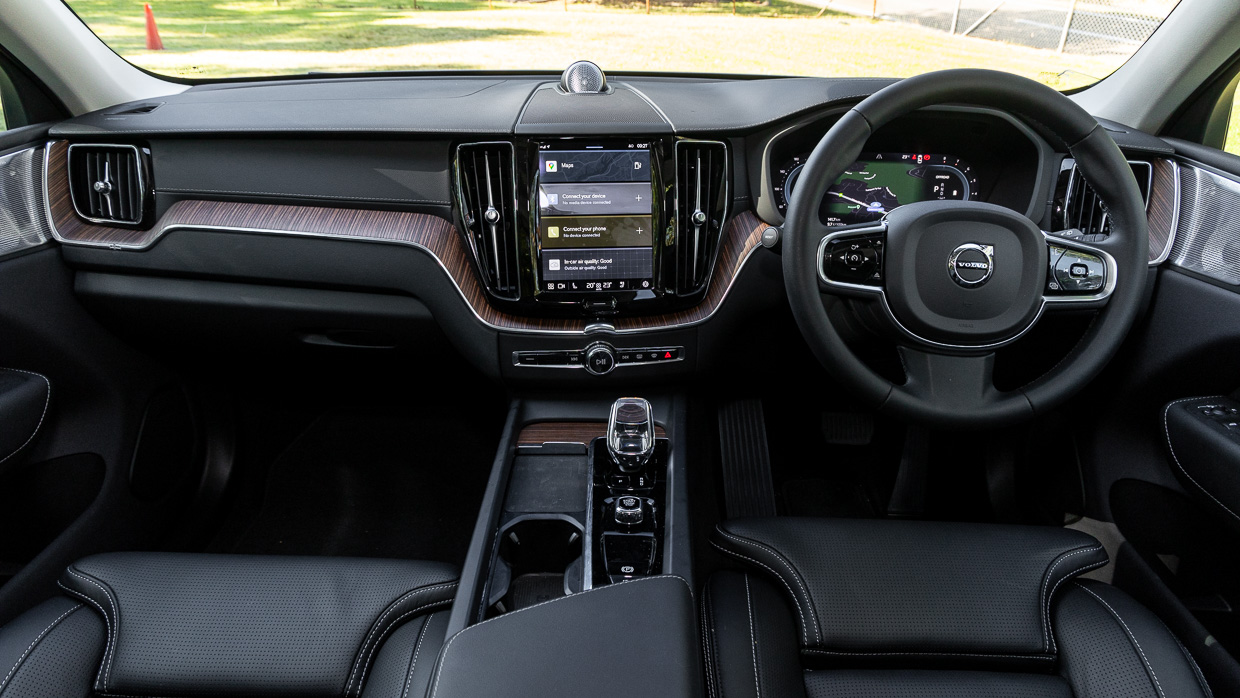
The horizontally split design punctuation by those almost art deco-looking air vents lends itself wonderfully to two-tone colour themes and Volvo offers plenty to the buyer, both in no-cost and cost-optional choices: a total of six for the Bright variant.
Ours is in Charcoal with the funky Linear Lime decor treatment: perhaps your reviewer’s least favourite of the $3150 optional perforated nappa leather combinations.
The alternative blonde (off white) and amber (tan) really bring the XC60 cabin to life, and the alternative Metal Mesh or Driftwood decor effects are more to my liking. You’ve got to love some choice.
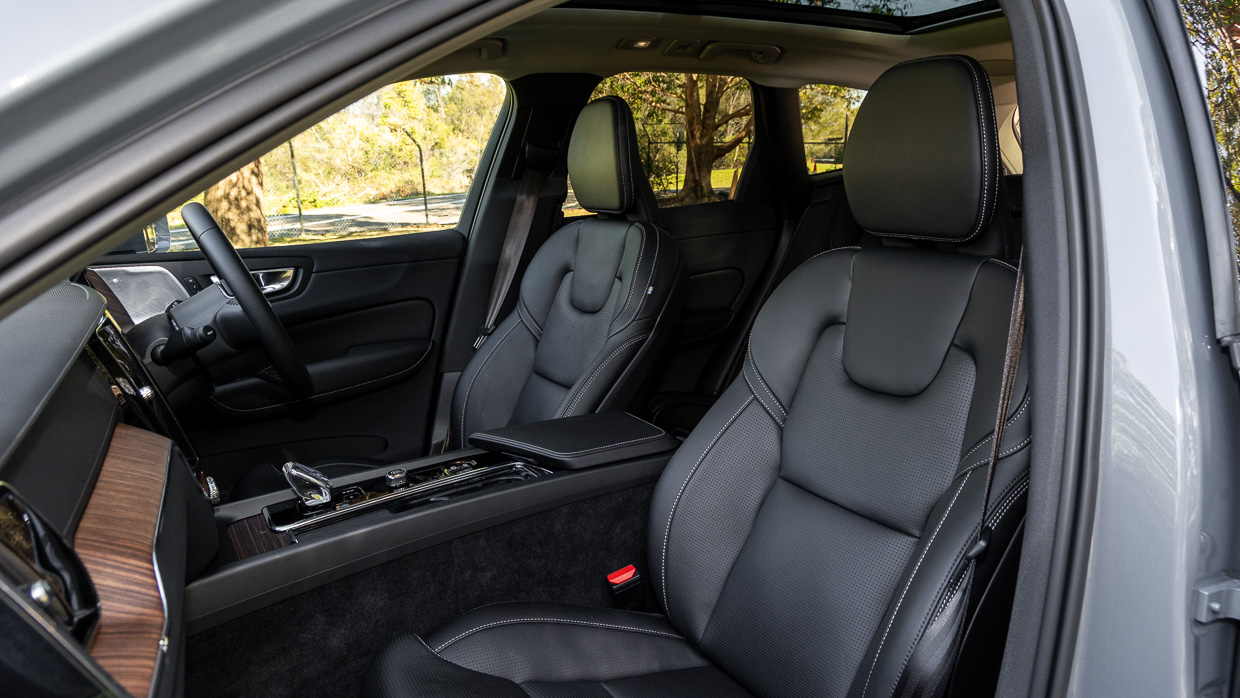
The seats themselves are good…once you’ve invested time in fiddling out the lumps in the electric adjustment. This isn’t without the odd surprise, because the massage functionality is very easily activated when you reach down to the hidden seat base to make other adjustments. That said, it doesn’t take long to acclimatise to the interface.
Where the cabin does start to date a little is in digital display work. The driver’s screen is large, clear and very neat, but it’s quite limited in skin choice: you either get Google-based mapping and a simple black background.
The somewhat small 9.0-inch portrait media system is the one area of the cabin that looks dated, if mostly in the face of the rapid growth spurt of infotainment screen size in recent times.
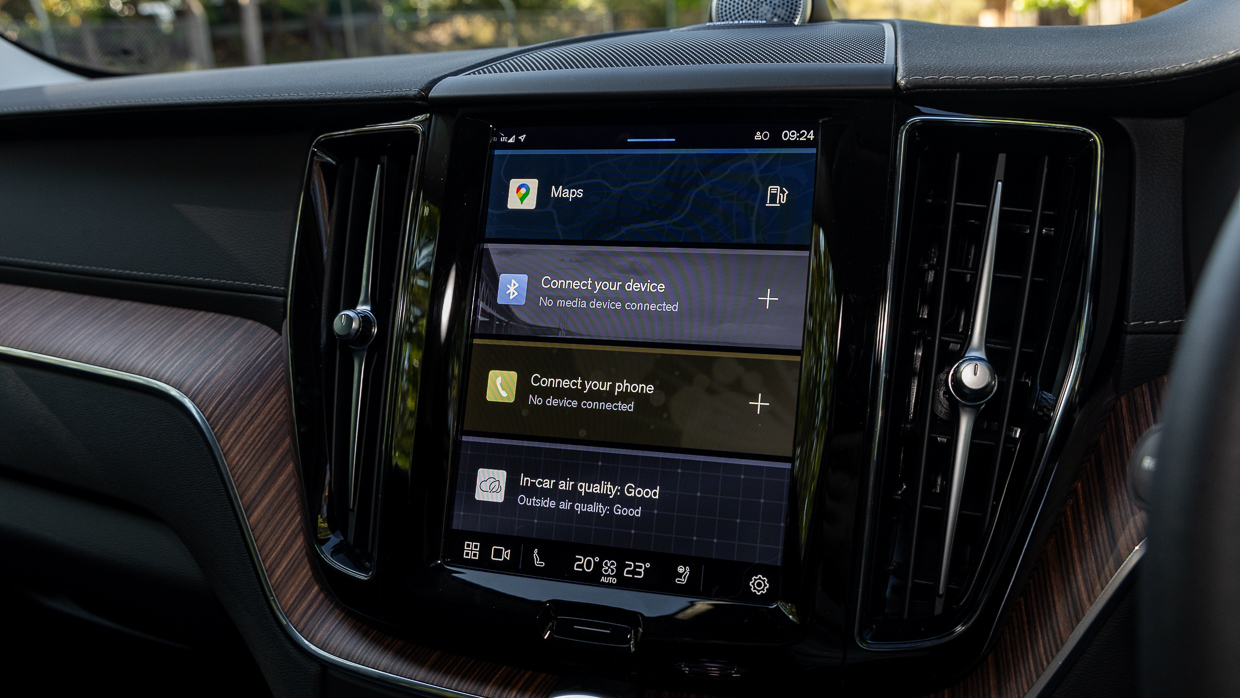
And its fundamental design – which apes an older tablet format, down to the home screen button – and Google Android architecture will please some users much more than others.
The menuing system gets a bit clumsy because it demands direct attention to navigate, which distracts on the move. And, again, the common default to control, say, media through the driver’s screen is not part of the XC60’s basic trick bag.
Apple CarPlay integration does seem a bit of an afterthought but, in fair play, the Google-centric format does reward Android aficionados. Strangely, Apple CarPlay is listed as wireless on Volvo literature, even if our XC60 refused to mirror either of my two phones over the air.
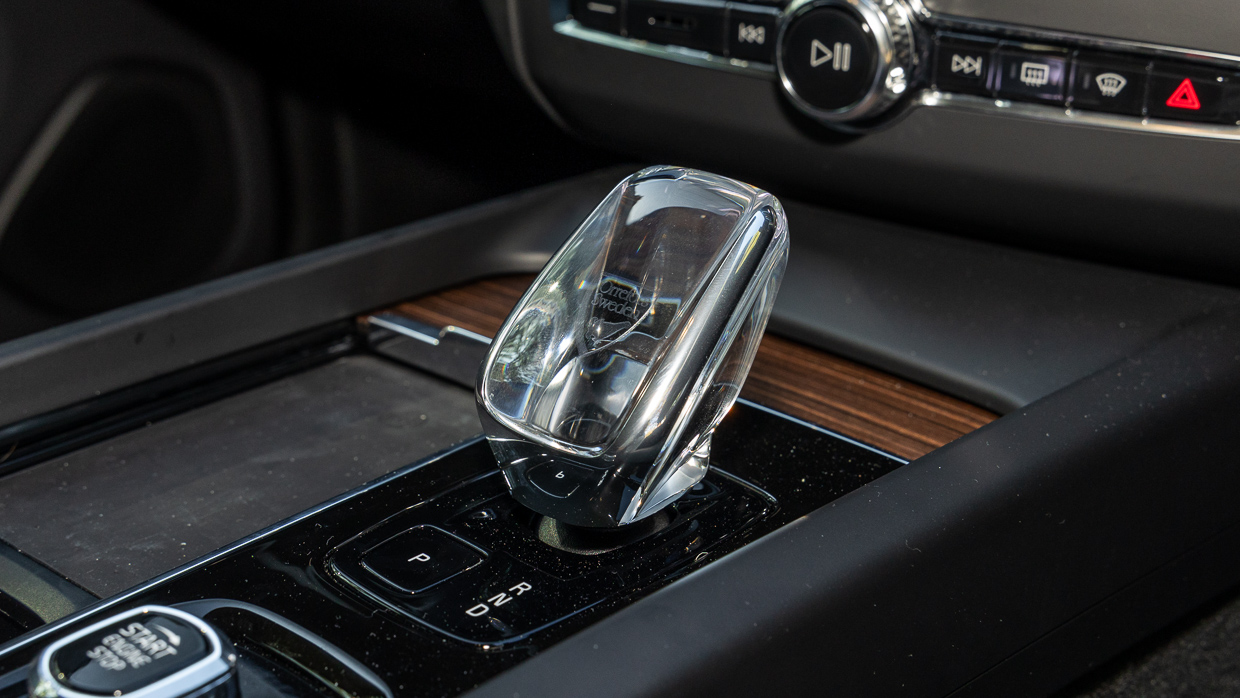
The same form guide also reveals that aside from a few details – a head-up display, a higher grade version of the CleanZone with Multifilter smarts, seat and wheel heating – there’s precious little in cabin to justify the $7000 divide between base Pure and as-tested Bright in terms of interior goodies.
They’re mostly indistinguishable and much of our tester’s finer details – the glass roof – costs extra anyway.
Regardless of trim level, much of the XC60 is refreshingly simple and straightforward to use. I love the large rotary volume control with its pause/play button for the audio system, the console controls are user friendly and the steering wheel controls are large and easy to navigate.
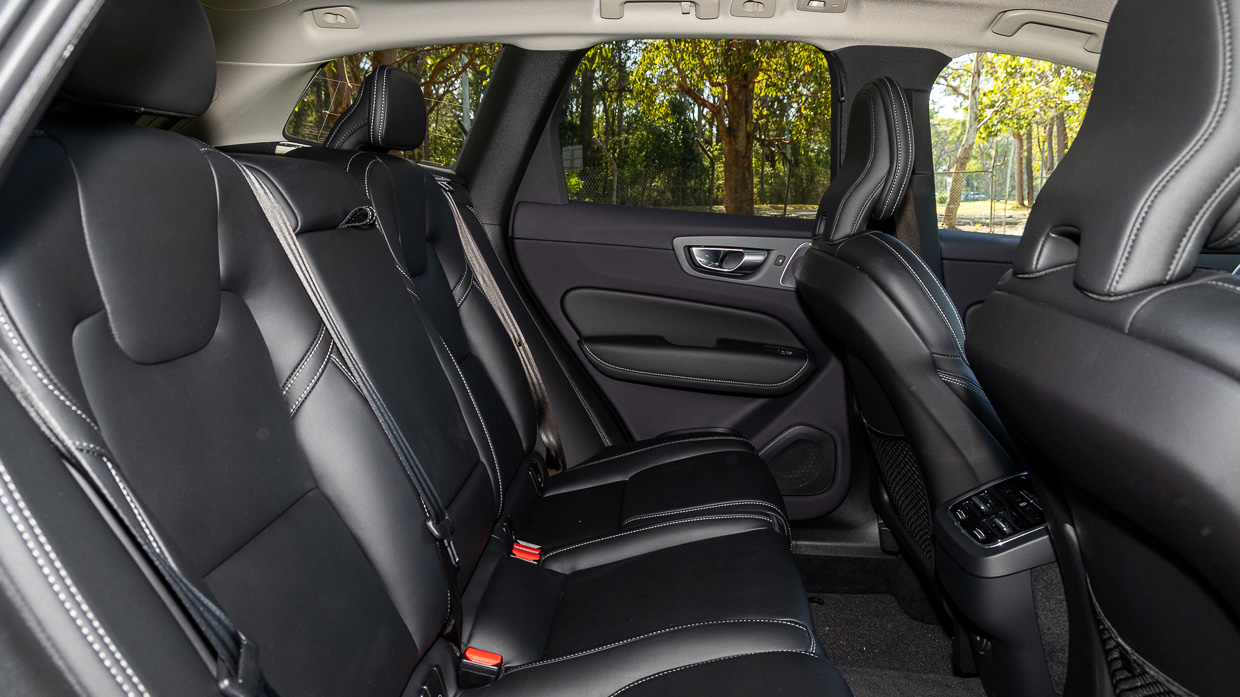
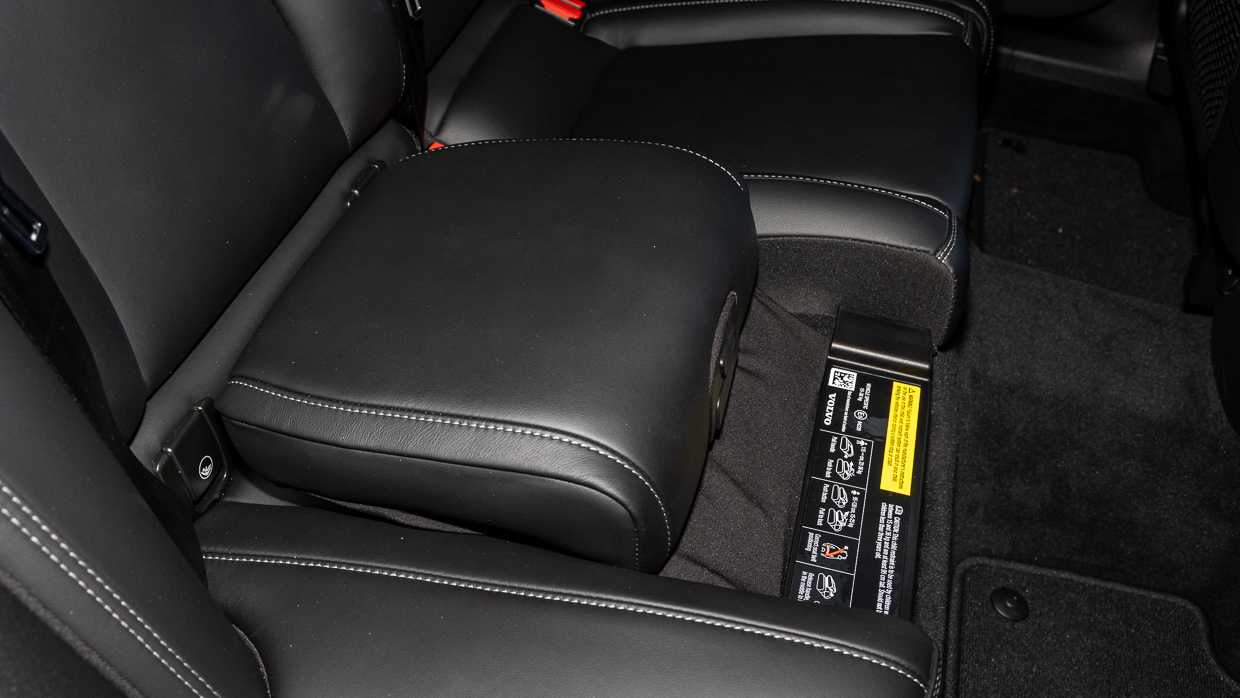
The XC60 does present a strong row two, with oodles of roominess, a continuation of the high-grade presentation and sense of quality, and excellent outward visibility from the generous glass house.
The dedicated third and fourth zone climate control (as mirrored in base Pure) are quality touches, as are the auto dimming reading lights.
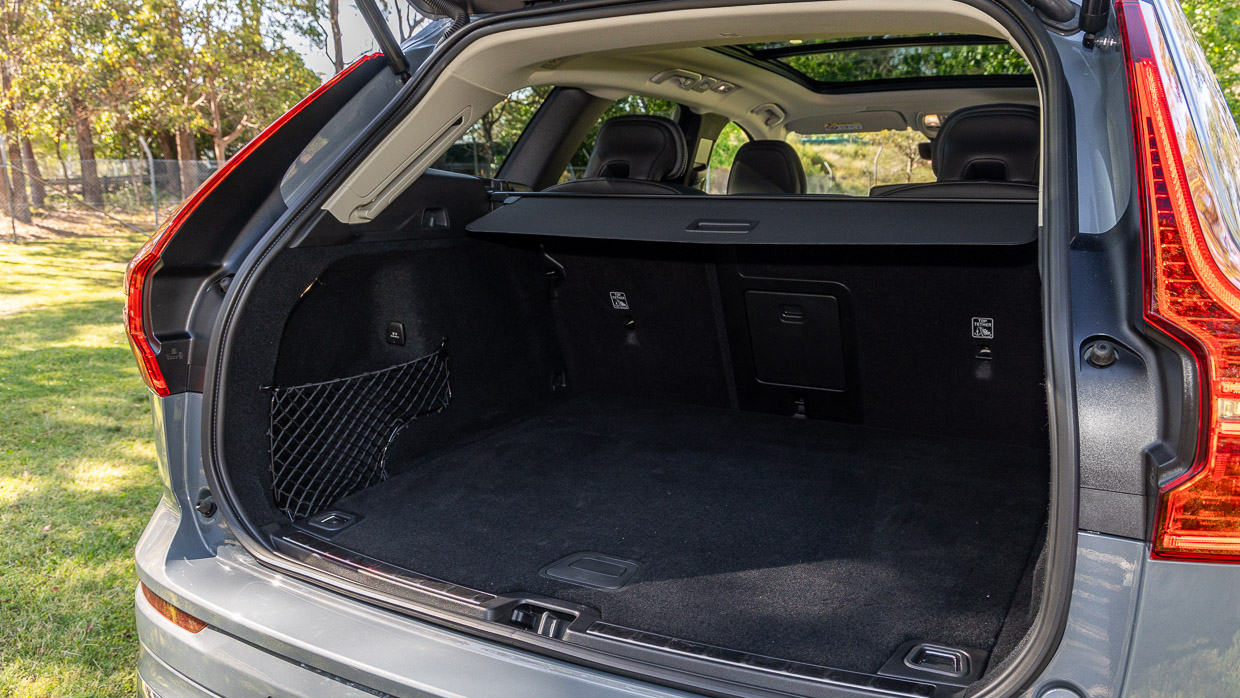
We’ve praised them before and we will again: the integrated booster cushions, that pop out of the rear bench seat base to afford youngsters higher seating positions and better outward visibility, are nigh on genius.
The hands-free tailgate opens to reveal 483 litres of nice, squarely proportioned boot space that doesn’t set any volumetric benchmarks but does prove highly usable for real-world practicality. The XC60 fits a large space saver spare under the boot floor.
The Volvo XC60 was awarded a five-star ANCAP rating way back in 2017 which has since expired as of December 2023. It applied to the current B5 and B6 version but not the PHEV T8 variant.
Although old the scoring for its time was exceptional in the areas of adult occupant protection (98 percent) and safety assist (95 percent), although the report acknowledges a lack of junction and reversing AEB at the time of assessment. Child occupant and pedestrian protection rated at 87 and 76 percent respectively.
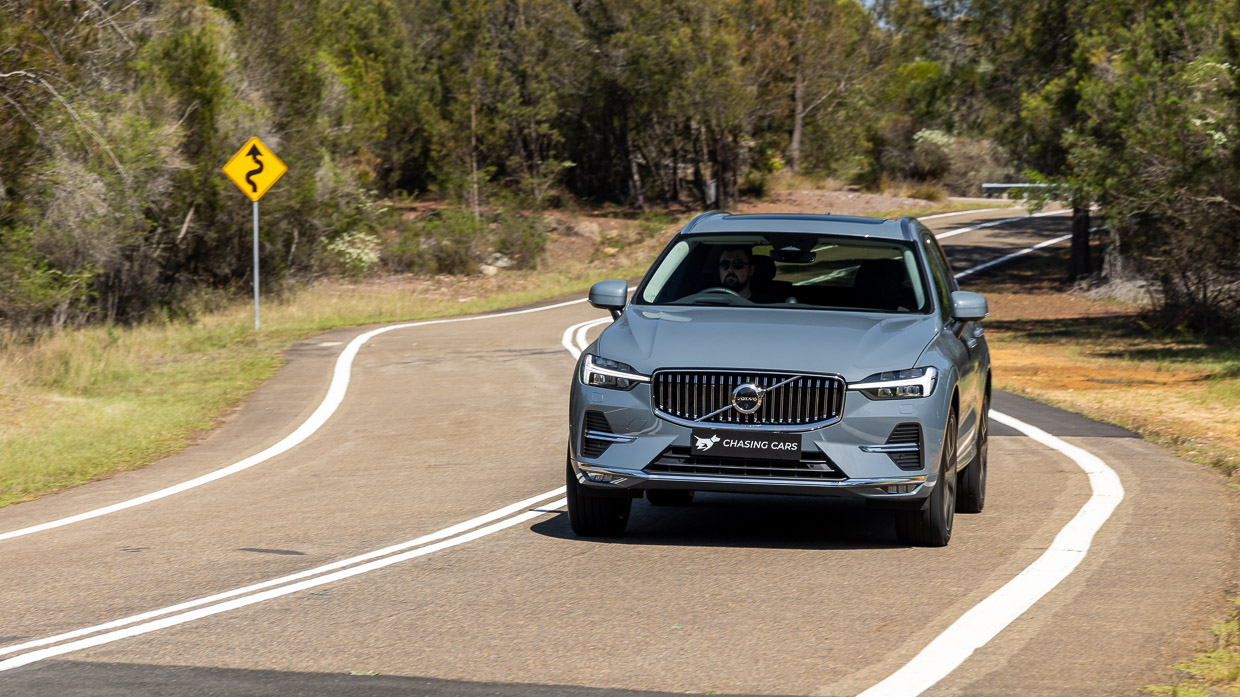
The XC60 B5 fits this following features:
All in all, the safety systems do, for the most part, work seamlessly and transparently. If there’s one recurring annoyance, it’s that the vehicle perimeter sensing system can become trigger happy in bumper-to-bumper traffic where it defaults to parking sensing assistance.
For a long while, one of the biggest deterrents to Volvo ownership was the exorbitant servicing costs.
Volvo Australia maintained that the high outlay was due to quality componentry and materials, though the reality is that Aussies will shop with their wallets, particularly where potential early-ownership issues are covered under warranty.
Then Volvo wised up a couple of years ago, deploying vastly more palatable capped price servicing packages. In the case of mild-hybrid XC60, a five-year pack costs $3000, averaging out to $600 per year- with 12-month, 15,000km terms – which is pretty reasonable for a premium European vehicle.
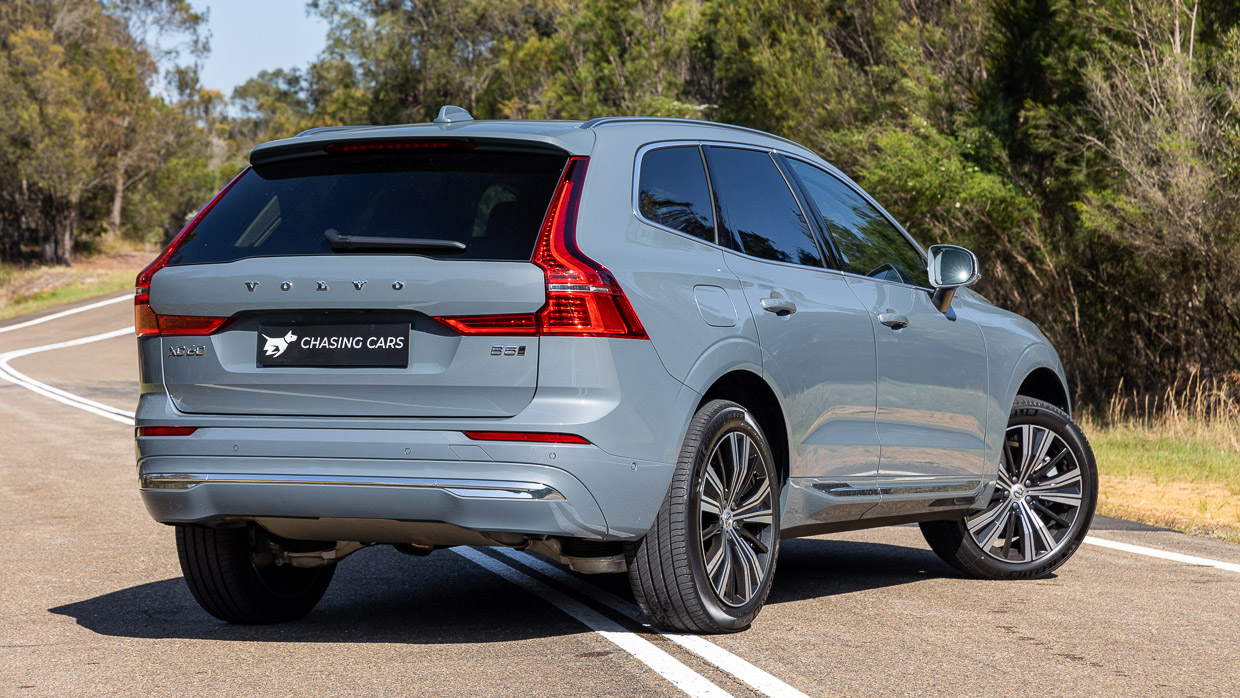
Warranty is a typical five years of unlimited-kilometre coverage.
Probably the biggest ownership consideration is fuel consumption. Again, our mild-hybrid B5-powered XC60 rarely dipped below 10.0L/100kms.
For relativity, a Lexus RX350h AWD – a proper series-parallel hybrid – typically hovers around the mid-sixes and low sevens on a combined cycle for a vehicle that’s roughly similar for power, size and weight.
After years of doing so, would I still recommend not to part with cash for a premium midsize SUV before checking out XC60? Indeed I would.
Despite its advancing age, the XC60 remains seductively handsome, its interior is still stylish, mature and pleasingly simple in the best of ways. And the hallmarks that make it hugely likeable and the panache that it originally brought to the Volvo brand still remain.
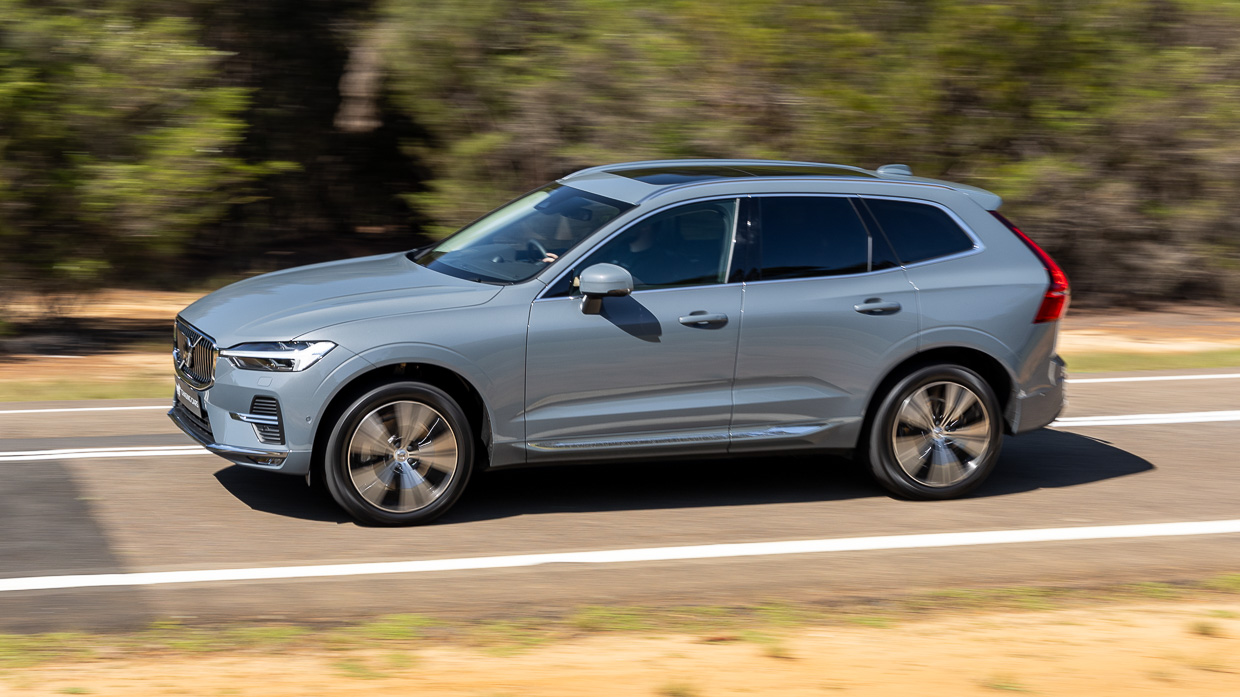
I just can’t endorse the Ultimate B5 Bright guise – let alone one bloated with cost options – as enthusiastically as other XC60 variants present and a good many past.
On one hand, the mild-hybrid turbo petrol B5 powertrain needs work and polish. And given all of Volvo’s internal combustion is on borrowed time, it’s a case of ‘don’t hold your breath’. In short, the 48-volt mild-hybrid augmentation just doesn’t pay any meaningful dividends.
I’m not convinced the Bright trim brings $9K worth of extra goodness over and above the base Pure. And I’m not convinced that the $16K of options fitted to our Bright – some of which, such as tinted rear windows, ought to be standard on a six-figure luxury vehicle – is money well spent.
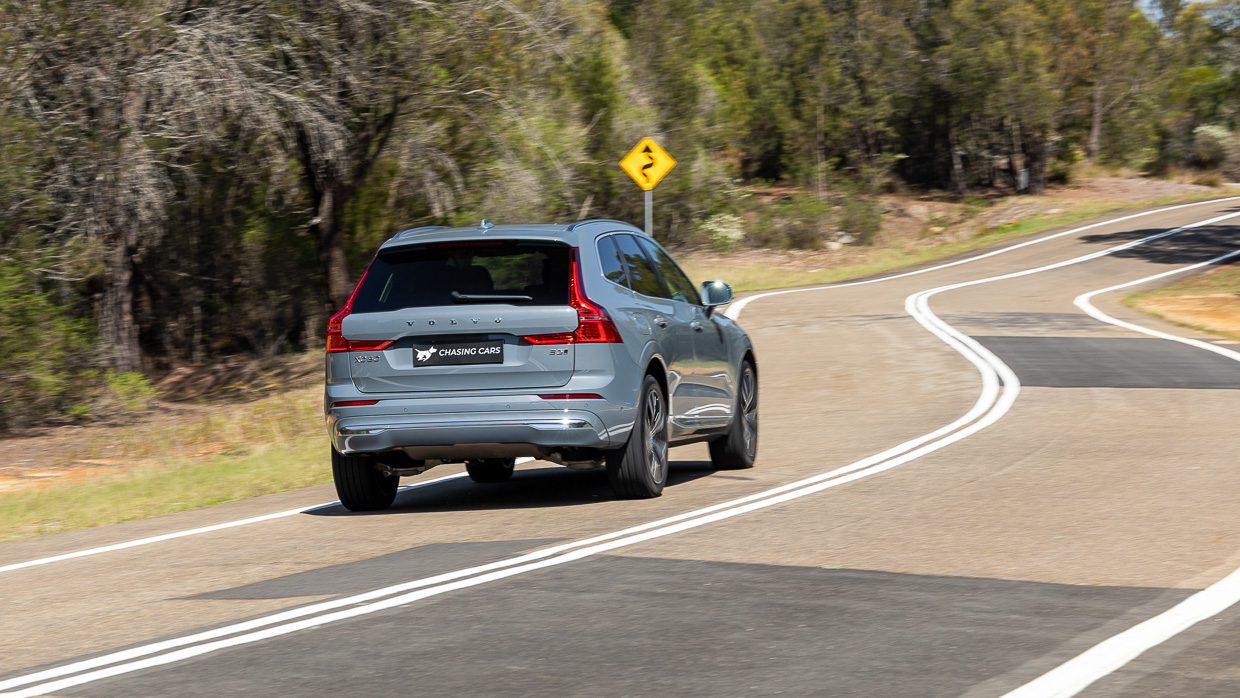
I can’t help feeling that the grade-higher, more-powerful Ultimate B6 Dark with just one key upgrade in air suspension represents slightly less outlay that’s much better spent.
It would also be remiss not to once again mention Volvo Australia’s fully electric 2026 promise and that a long-awaited electric XC60 replacement – surely to be called EX60 – is expected to surface on the world stage any month now.
Key specs (as tested)
About Chasing cars
Chasing Cars reviews are 100% independent.
Because we are powered by Budget Direct Insurance, we don’t receive advertising or sales revenue from car manufacturers.
We’re truly independent – giving you Australia’s best car reviews.
The estimate provided does not take into account your personal circumstances but is intended to give a general indication of the cost of insurance, in order to obtain a complete quote, please visit www.budgetdirect.com.au. Estimate includes 15%^ online discount.
^Conditions Apply
Budget Direct Insurance arranged by Auto & General Services Pty Ltd ACN 003 617 909(AGS) AFSL 241 411, for and on behalf of the insurer, Auto & General Insurance Company Limited(ABN 42 111 586 353, AFSL 285 571).Because we don’t know your financial needs, we can’t advise you if this insurance will suit you. You should consider your needs and the Product Disclosure Statement before making a decision to buy insurance. Terms and conditions apply.
Indicative quote based on assumptions including postcode , 40 year old male with no offences, licence suspensions or claims in the last 5 years, a NCD Rating 1 and no younger drivers listed. White car, driven up to 10,000kms a year, unfinanced, with no modifications, factory options and/or non-standard accessories, private use only and garaged at night.
^Online Discounts Terms & Conditions
1. Discounts apply to the premium paid for a new Budget Direct Gold Comprehensive Car Insurance, Third Party Property Only or Third Party Property, Fire & Theft Insurance policy initiated online on or after 29 March 2017. Discounts do not apply to optional Roadside Assistance.
2. Discounts do not apply to any renewal offer of insurance.
3. Discounts only apply to the insurance portion of the premium. Discounts are applied before government charges, taxes, levies and fees, including instalment processing fees (as applicable). The full extent of discounts may therefore be impacted.
4. We reserve the right to change the offer without notice.